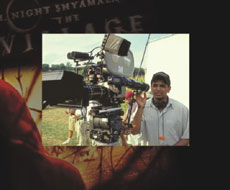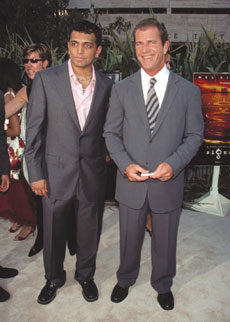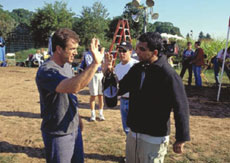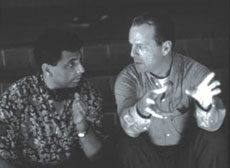| |
Merchant of Suspense
He has been compared to Hitchcock and Spielberg but M. Night Shyamalan has
taken cinematic suspense and thrills to an altogether higher plane. The
Pondicherry-born writer-director is clear about two things: he wants to keep
scaring people’s wits and take home an Oscar for his grandfather.
By Rakesh K. Simha
He “M” in M. Night Shyamalan is certainly not
for “modest”. In an interview with a US TV channel, Shyamalan said: “People ask
me, why are the movies so successful? Why in so short a time?” “Because,” he
explains, “they are me.” Bob Dylan, says the boyish, ebullient filmmaker, whose
troika of supernatural hits has grossed over $1 billion worldwide, is one of the
great singers of all time because he’s him.
 |
|
Now take this. In 2003,
when The Village opened, it wasn’t Oscar-winner William Hurt or Alien-buster
Sigourney Weaver, but the Philadelphia-based director’s name that was used to
sell the suspense movie. His distinctive moniker sat boldly atop the film’s
title in print promos, posters, indeed, every aspect of the media campaign.
Cut to 1978. Penn Valley, Pennsylvania. Ten-year-old Manoj Shyamalan empties his
piggy bank, buys himself an 8 mm camera and quickly becomes the family’s
documentarian, creating characters out of cousins and recruiting the
neighbourhood kids for his onscreen adventures, simple takeoffs on the latest
theatre offerings: James Bond, starring Manoj as the super-suave spy; Friday the
13th, Part VI, at a time when there |
were only two; Nightmare on Old Gulph, in which the
victims are chased by a fedora on a stick. Fast-forward to a close-up of
Shyamalan’s senior page in the Episcopal Academy yearbook in 1988. It’s a
photograph of the filmmaker as a young man mocked up as a Time cover with the
headline: NYU GRAD TAKES HOLLYWOOD BY STORM. He designed the page before college
acceptance letters even went out.
|
The most
striking thing about Shyamalan, besides the speed of his success, is a
confidence that virtually walks. This is a guy who considers his foiled attempt
to direct Labor of Love, the second script he ever wrote and which he sold for
$750,000, a major disappointment.
And his successes so far outshine the
“setbacks” he enumerates that it seems important to remind him that six years in
the business is not, after all, a long time to get where he is. The Shyamalan
oeuvre is a quick list of hits that started in 1993, the year he graduated from
NYU, with Praying With Anger, which he
wrote, directed and |
|
 |
starred in. The film, about a young American whose
trip to India is a spiritual journey to find himself, had a brief turn in
independent theatres in the US and was named Debut Film of the Year by the
American Film Institute.
In 1995 Shyamalan was asked to
write the script for a combined live action-animated version of the E.B. White
children’s classic ‘Stuart Little’ and it was released on the big screen in
1999. In 1997 he made his second film ‘Wide Awake’. Shyamalan’s third directorial
effort, the supernatural thriller ‘The Sixth Sense’ in 1999, was one of the
year’s biggest box office hits. It scored six Academy Award nominations,
including one for Best Picture and two for Shyamalan himself for Best Director
and Best Original Screenplay. This film, about a 11-year-old disturbed boy who
can see the dead, won two Golden Globe nominations and the 26th annual People’s
Choice Award for favourite dramatic film. Following the success of this film, he
directed another supernatural thriller ‘Unbreakable’ in 2000, about a man who
undergoes mysterious changes following a train accident. In 2002, Shyamalan
directed ‘Signs’ an emotional story, which deals with crop circles in rural
Pennsylvania. “It should be the only movie you ever cried at and screamed at,”
he says.
 |
|
‘In 2003 came the chilling tale
of a close-knit community that lives with the frightening knowledge that
creatures reside in the woods around, and the courage of one young man who
challenges the unknown creatures in the film ‘The Village’.You can even call him Scheming
Shyamalan. In 1994, 20th Century Fox bought Labor of Love, leaving him out of
the loop. Disappointed at losing directorial rights to his story about a man’s
love for his dead wife, he went home to start over. “I sat down, and I said, I’m
going to write another screenplay, but I’m going to write no male leads in the
movie.
If there are no white male leads in there, then it doesn’t instantly go
into the we-gotta-get-Tom-Cruise-Tom-Hanks, gotta-get-a-director-who-can-get-them
pile. So I wrote Wide Awake, which stars a 10-year-old kid.”The younger child of Indian
immigrants, Shyamalan has a deeply ingrained sense of the supernatural.
|
Growing up on the upper-crust
Main Line, he was a regular participant in his Hindu parents’ religious rites in
the home. Like his parents, he believes in life after death, and at 18 adopted
the Native American “Night” as his middle name, because he feels he may have
been an American Indian in a past life.
That the earthly and spirit
worlds coexist easily for Shyamalan comes through in his movies, as in the most
compelling scene near the end of Praying With Anger, when the young American
encounters his dead father’s spirit, in the shape of a shadow, caressing him in
a darkened room. It’s also the reason why Sixth Sense is one of the most
believable horror stories ever.
Shyamalan’s great technique is
to scare and terrorise you by not showing too much. Leaving more to the
imagination was a technique perfected by the ultimate master of suspense, Alfred
Hitchcock, and Shyamalan has picked up the scent. He leaves out the gore and the
blood and it makes for infinitely better viewing.
Shyamalan also has the unique
ability to extract first-rate performances from child artistes. He did it with
Haley Joel Osment in “The Sixth Sense”. And he has repeated it with Rory Culkin
and Bo Abigail Breslin in “Signs”.
In a phone-in chat with Indian journalists, Shyamalan was matter-of-fact about the subject: “Actually I am shocked that kids
are not in every movie. They are a third of the planet and are a gigantic part
of our lives and not to have them in a film seems strange.” |
|
 |
Besides, he has the uncanny
knack of picking the right artiste for each role. More conservative filmmakers
would have probably gone in for more established actors like Tommy Lee Jones or Tom Hanks. Shyamalan, like Spielberg again, is more daring. Selecting action
heroes to do soft and dark roles was a gamble and it has paid off handsomely. To Shyamalan, the making of a
movie is an attempt at some kind of a cultural phenomenon, and “The Sixth Sense”
definitely was one. People were discussing the film, rabbis were preaching about
it, Jay Leno was focussing on it and Haley Joel’s “I see dead people” line fast
became one of the most quoted cinematic lines,
until even Bart Simpson was writing, “I can’t see dead people. I can’t see dead
people” on the blackboard.
Here was a film that used less
blood to tell its story than a “Nightmare on Elm Street” would use in one shot
and yet managed to scare people many times over. Shyamalan has said in an
interview, “Freddie Krueger with the blood—that doesn’t really scare me. What
scares me is something like this: if I had a photo of my wife on my desk, and it
was face down, and I put it up and I walked out of the room and I came back and
it was face down again. That’s scary.”
Suspense, in a Shyamalan film,
is like an invisible animal in the room. There is a sense of foreboding,
something hidden within the atmosphere that is about to attack—but decides to
leave just before it attacks. As he has said, “I don’t like to show everything,
I like to prolong the revelation. I like to show the footprint of the creature
without showing the creature.” Definitely more Hitchcockian than Spielberg’s
rather popcorn-crunching style.
Shyamalan is in many ways like
Spielberg in reverse, in the sense that he’s darker, spookier, and also has a
religious faith. Family is important in Shyamalan’s films. Shyamalan is indeed a “very
scary guy,” says Bruce Willis, who acted in Shyamalan’s two hit films, The Sixth
Sense and Unbreakable. To be sure, Willis was referring to Shyamalan’s steadfast
passion and lengthy rehearsals. Following the success of Sixth
Sense, which is now among the top dozen grossers of all time, Shyamalan insists
on directing all the scripts he writes. And each of his movies is set in or
close to Philadelphia because, he says,
he likes to go home for dinner to his wife and kids.
Shyamalan, who was born in
Pondicherry, lives in the Philly suburb of Conshohocken with his wife Bhavana
Vasvani and their two daughters.In a recent story on Shyamalan,
Esquire magazine wrote: “From the beginning of his career, Shyamalan has
politely demanded complete control over the stories he tells.” He has never been
anyone’s assistant. He has never worked in Hollywood. As a director, he has
worked only on his own scripts. |
|
 |
 |
|
Shyamalan, who is only 34,
employs a single associate who serves as creative consultant and conducts
business over an unlisted phone number. His small film company, appropriately
for the kind of movies he makes, is called Blinding Edge Pictures.
“All this he can do because his
last movie, The Sixth Sense, grossed $650 million worldwide. The only other
directors who achieved this kind of success at this age are named Spielberg,
Lucas, and Cameron,” Esquire said.
|
It’s what he had to contend
with when, as a 17-year-old high-school senior, he told his doctor parents he
wanted to make movies-not at all what had been planned for the stellar student,
whose unspoken promise of success meant a career in medicine or business or
computers. “I was not very happy in the beginning,” Nelliate Shyamalan, the
filmmaker’s father, admits. “He was going into a tough profession, in which only
a few people come up. We’ve had a very pleasant surprise.”
The downside? Says Night, “Now
the whole family has these high expectations. My grandfather in India wants to
see me holding an Academy Award on the TV. And I really want to do that for
him.”
|
|